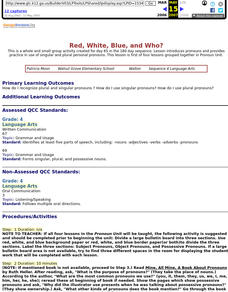Curated OER
Glaciers
Seventh graders summarize how Earth processes today are similar to
those that occurred in the past. They read excerpts from John Muir's "Yosemite Glaciers" and explain how slow geologic processes have large cumulative effects over long...
Curated OER
PICTURE PERFECT PYRAMID
Students create a model of the USDA's Food Pyramid Guide, using shoe boxes. They bring an assortment of shoe boxes from home. Students are given a copy of the "Food Guide Pyramid." They wrap boxes for the bread group in white, the...
Curated OER
Food Comparison PDF
In this health worksheet, students are led through lessons to become familiar with the dietary recommendations of the government.
Curated OER
Using Real-Data from North Dakota to Study Place Value, Rounding, Estimation, Fractions, and Percents
For this real-data worksheet, students use data from the 2008 Census Bureau to answer eight questions divided into four activities. The topics covered include: place value, rounding, estimation, fractions, and percents.
Curated OER
Footprints
Students explore patterns. In this patterns geometry lesson, students identify and extend patterns including body parts, movement, geometric shapes, noises, and footprints. Students create and share an original pattern.
Curated OER
The Living Environment
Students use a spoon, clothespin, scissors, and toothpicks to simulate how animals get food in their environment. In this environment lesson plan, students learn about the adaptations animals make in order to survive.
Curated OER
What is a Tangram?
Students identify a tangram. In this geometry activity, students read Grandfather Tang's Story and retell each story using the tangrams on a flannel board. Students use tangrams to complete an included worksheet.
Curated OER
Civil Rights
Twelfth graders survey how controversial court cases have changed the viewpoints of civil rights. In this U.S. Government lesson, 12th graders work in small groups to prepare summaries of specific court cases, then present their...
Pennsylvania Department of Education
Using the Coordinate Plane in Problem Solving
Fifth graders practice solving problems. In this fraction and decimal lesson plan, 5th graders recognize the relationship between fraction and decimals. Students estimate problem results and write expressions to use for problem solving.
Curated OER
Exploring Centers of Triangles
Students explore properties of triangles using angle bisectors, incenters, circles, midpoints, and altitudes. They use Geometer's Sketchpad in order to create triangles and their properties.
Curated OER
Piece of the Sky: Introduction for Making S'COOL Observations
Learners observe and discuss cloud cover. They identify percent of cloud cover, calculate cloud cover by fraction and convert to a percent, and compare their models with the current real sky cloud cover.
Curated OER
How Did We Arrive at the Printed Book?
Seventh graders, in cooperative learning groups, research the development of book printing. After examining a story written on a scroll, an accordion book, and a printed copy, they evaluate them according to a certain criteria and...
Curated OER
Red, White, Blue, and Who?
Fourth graders are introduced to pronouns and provided practice in use of singular and plural personal pronouns.
Illustrative Mathematics
Combined Fuel Efficiency
Practice simplifying complex fractions and long division of polynomials with this brief exercise. These four questions make a challenging warm-up activity or a short, but comprehensive, follow-up after a detailed lesson on algebraic...
Curated OER
Groovy Grooping
First graders listen to the teacher read "The M&M's Addition Book." They estimate the number of gum balls in a bag. Students use unifix cubes to estimate the number of gum balls each student will receive. The indicated worksheet and...
Curated OER
What Are the Odds?
Middle schoolers identify and interpret various ways of expressing probability as a decimal, fraction, percent, or ratio. They solve problems based on probability as they apply to real world applications.
Curated OER
I Must/ I Must Not
In this ESL word and picture comprehension worksheet, learners examine seven pictures and complete a multiple choice question for each. They answer the question that contains the words "must not" or "must."
Curated OER
ESL: Beginning Vocabulary Matching
Beginning English Learners match 10 line-drawn pictures of basic nouns with their names, such as kite, airplane, goat, and igloo. Indefinite articles are included, so this exercise also provides reinforcement for the a/an rule.
Curated OER
Various Questions
A great exercise for English language learners or youngsters learning how to question, this resource provides practice using pictures to recognize words. After the class has completed the fill-in-the-blank portion, have them walk around...
Curated OER
ESL: Basic Vocabulary Matching
Newcomers to English can practice vocabulary about food, daily actions, and school supplies with this 10-question matching exercise. Simple line drawings represent basic terms for beginners.
Curated OER
ESL: Classmates Survey
Get your beginning English Learners moving with this class survey. They ask each other the 8 questions provided to find out "How many of your classmates..." Good practice for asking questions that start with"Do you..." including "make...
Curated OER
Match: Word and Picture Comprehension
An excellent ESL word and picture matching worksheet awaits your students. They analyze seven pictures of body parts, and match these to the words that describe them.
Curated OER
ESL: Practice Using Present Progressive Tense
Small, cartoonish pictures of people expressing emotions and actions (blowing his nose, holding her head and frowning, dancing, smiling) provide the basis for writers to describe the feelings and experiences taking place. Help your ESL...
Curated OER
Yo! Gert-making yogurt
Young scientists or chefs culture yeast to produce yogurt. The materials and a general description of how make yogurt are provided, but there is very little detail otherwise. You could use this as an activity when your biology class is...

























